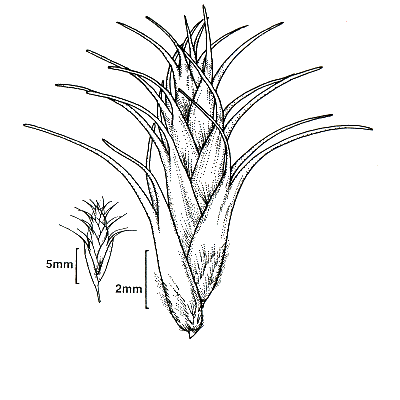Triodia prona M.
Lazarides. Austral. Syst. Bot.
10: 463 (1997).
Classification. (GPWG 2001) : Subfamily
Chloridoideae. Triodeae.
Type of Basionym or
Protologue Information: Western Australia: Northern Province; near
Thompson's Springs, Carr Boyd Range, 40 miles (64.5 km) south-east of Kununurra,
3 Mar 1963, Lazarides 6715 (HT: CANB; IT: CANB, DNA, K, PERTH).
Key references
(books and floras): [2002] D.Sharp & B.K.Simon, AusGrass, Grasses of
Australia.
Illustrations:
[2005] K.Mallet (ed.), Flora of Australia 44B: Poaceae 3 (Fig.
36A-B).
Habit.
Perennial. Culms decumbent, 60–130 cm tall. Leaf-sheaths scaberulous, glabrous
on surface. Leaf-sheath auricles absent. Ligule a fringe of hairs, 0.3 mm long.
Leaf-blades flexuous, filiform, conduplicate, 15–30 cm long, 0.6–0.7 mm wide.
Inflorescence.
Inflorescence compound, a panicle. Panicle linear, loose, 20–30 cm long, 1–1.5
cm wide.
Spikelets.
Spikelets pedicelled. Fertile spikelets many flowered, with at least 2 fertile
florets (4–5), comprising 4–5 fertile floret(s), with diminished florets at the
apex, cuneate, laterally compressed, 7–10 mm long.
Glumes.
Glumes similar, thinner than fertile lemma. Lower glume lanceolate,
cartilaginous, much thinner on margins, without keels, 1(–5) -nerved. Lower
glume surface glabrous. Lower glume apex mucronate or awned. Upper glume
lanceolate, 7–9 mm long, cartilaginous, without keels, 1(–5) -nerved. Upper
glume surface asperulous, glabrous. Upper glume apex entire or lobed, mucronate
or awned.
Florets.
Fertile lemma 3.5–4 mm long, without keel, 3–9 -nerved. Lemma surface
indumented. Lemma apex lobed, awned, 3 -awned. Median (principal) awn 5–6 mm
long overall. Lateral lemma awns present. Lodicules present. Anthers 3.
Continental
Distribution: Australasia.
Australian
Distribution: Western Australia.
Western Australia:
Gardner.
Notes.
Known only from the type collection.
The species is distinguished by the procumbent
flowering stems which are unique in the genus. In spikelet morphology it
resembles P. salina, but this is a highly resinous species with much
longer lemma lobes and awns.
Known
only from the type locality in the East Kimberleys, W.A. Infrequent on lower
slopes of sandstone mountain range; flowers March.



